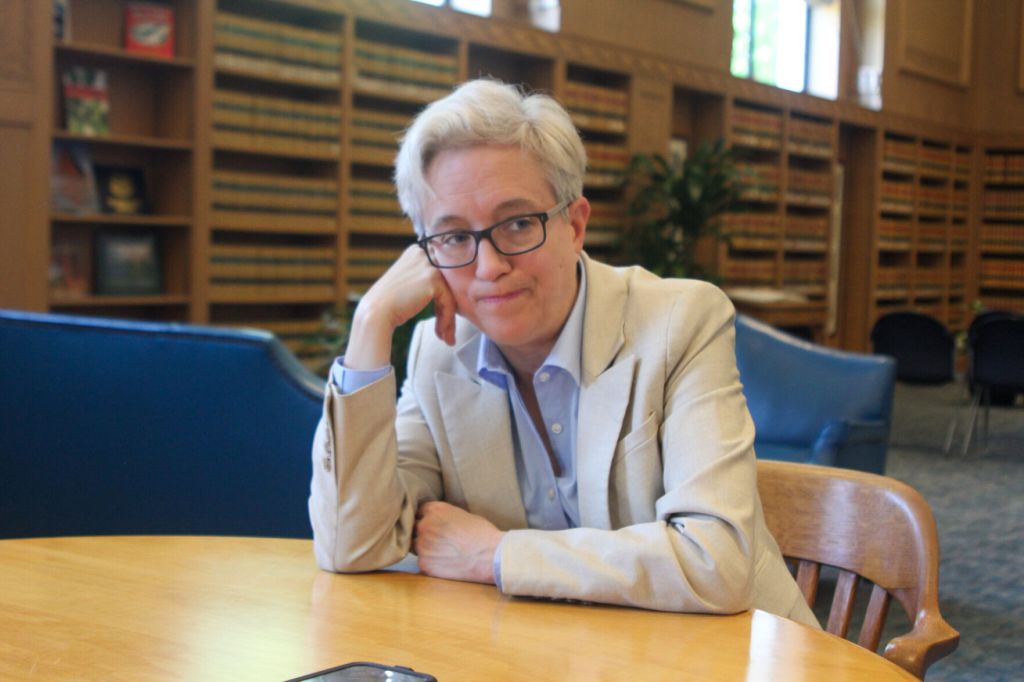Governor says recovery efforts from wildfires must start immediately
Published 3:30 pm Monday, September 9, 2024

- Gov. Tina Kotek is shown here talking to the Oregon Capital Chronicle in the ceremonial office of the State Library of Oregon in Salem in May. Since then, Kotek met with EO Media Group Sept. 5, 2024, and answered questions on wildfire response, housing shortages, the climate of agricultural decline and more.
LA GRANDE — Even though the 2024 wildfire season in Oregon isn’t over, Gov. Tina Kotek says work to recover from the “unprecedented” blazes needs to start immediately.
Kotek made her comments Thursday, Sept. 5 in an online meeting with EO Media Group reporters and editors. During the 30-minute session, Kotek answered questions on topics including wildfires, the state’s housing crunch and Greater Idaho.
On the wildfires, the governor said, “We’re working really hard to make sure we’re out there getting resources, keeping things from getting out of hand and protecting lives and property, but recovery has to start right away.”
She said she’s focusing her efforts on taking a hands-on approach to getting resources allocated and addressing wildfire emergencies with urgency.
Kotek pointed to an interagency sharing agreement, which she said has been a key component of the state’s response to the wildfires, which thus far have burned more than 1.7 million acres in Oregon. She said the agreement makes it easier for state agencies to share data, which should facilitate faster responses.
Kotek declared a statewide emergency due to the wildfires on July 12. On July 31, she requested a disaster declaration from the U.S. Department of Agriculture as the state battled over 120 active fires.
The letter from Kotek to Agriculture Secretary Tom Vilsack urged the department to issue a USDA disaster declaration for 23 Oregon counties, including Baker, Gilliam, Grant, Harney, Malheur, Umatilla, Union and Wallowa.
Kotek’s request, which was backed by every member of Oregon’s congressional delegation, would grant emergency-use authorizations for alternative grazing areas and flexibility in grazing schedules. It also would grant emergency waivers for the use of noncertified weed-free forage.
“We are working very hard to get every dollar from the federal government to help communities, particularly in Eastern Oregon, where you’ve seen huge fires on rangeland (and) grazing has been significantly impacted,” she said.
On Monday, Sept. 9, Agriculture Secretary Thomas Vilsack said the USDA was deferring a decision on the emergency declaration. “At this time, USDA is unable to make a complete and accurate determination of production losses,” Vilsack said in a letter to Korek. As soon as accurate information about crop losses is available, he said, the agency would decide Kotek’s request.
Vilsack said the Natural Resources Conservation Service has offered $2 million in emergency funding to ranchers and farmers affected by the wildfires and the Forest Service can help ranchers find solutions to the grazing and weed-forage challenges. (A copy of Vilsack’s letter is attached to the online version of this story.)
One theme — the shortage of affordable housing in Oregon — ran through a number of Kotek’s answers to different questions. She noted, for example, that employers in rural Oregon frequently offer jobs to would-be employees, but those employees can’t take the jobs because they can’t find affordable housing.
“We just don’t have enough housing,” said Kotek, who has made increasing the number of housing units throughout the state a priority.
But she said she was encouraged by solutions being tried throughout Eastern Oregon, such as the Tiger House in La Grande.
In the Tiger House project, students at La Grande High School are learning how to build homes with plans for Grande Ronde Hospital to buy the homes for workforce housing.
Housing also came up when Kotek was asked about a significant decline in dry onion production in Eastern Oregon’s Malheur County.
Kotek speculated that some of the decline was due to growers relocating across the border in Idaho in the wake of severe winter storms that devastated structures in the county in 2016. She also said it’s possible that a lack of housing for agricultural workers also fueled the relocations.
“Ag is just a very difficult industry, right? So (we’re trying to make sure) that on low margins, we’re supporting those growers and processors in a way so they can stay in Oregon. There are no easy answers to that,” Kotek said.
As for the Greater Idaho movement, which seeks to realign a number of counties in Eastern Oregon with Idaho, Kotek was asked about an invitation the movement’s leaders issued in July for a meeting. Kotek, noting that she’s had a busy summer, said she still hasn’t decided how to respond to the invitation — or if she should respond at all.
But she said she understood the frustrations of Eastern Oregon residents who believe that their voices routinely go unheeded in Salem.
“We need to have good conversation,” she said. “And I think what I’m trying to figure out is, what’s the best way to continue that conversation with Oregonians?”
She said she’s considering reaching out to county commissioners in Eastern Oregon, and ask their opinions about the best ways to proceed.
“I want to make sure that these are constructive conversations, because I want people to believe in Oregon, stay in Oregon,” Kotek said. “But I also want their grievances and concerns to be heard and addressed and trying to figure out the best way to do that is where I’m going to focus.”
With the new school year beginning, Kotek also talked about efforts to improve and emphasize school attendance.
“The first month of school is really critical, making sure students know that showing up makes all the difference,” Kotek said. “You can’t learn if you’re not in school.”
Addressing summer camp and after-school program funding is on Kotek’s agenda for the next legislative session, she said. She wants to ensure a consistent stream of funding to support summertime programs, which she said help students prepare for the school year.




